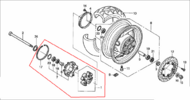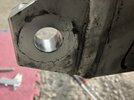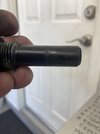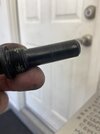I just opened 4 new rear caliper brackets and they are all completely smooth with no “damage” or “flute” marks.
Just a guess, but perhaps the assembler didn’t follow the correct procedure at the dealership, after all these are usually 16 year old kids who only break down shipping crates, wash bikes, and put things together when the technician’s are too busy.
The marks you see are Damage, plain and simple.
They can cause howling and dragging issues.
When the SMC starts dragging, or putting pressure on the front clip, it wears away and slopes downward.
The clip then gets clearance or a gap so the clip can tilt, for a lack of a better term.
And if the pads tilt, they bind, binding causes chatter against the stopper plug etc.
Think of “grabby rear brakes” every time they grab or bind against the rotor, the caliper slams against the stopper plug bracket.
If you have 150,000 miles on your SMC, and see these signs, it’s telling you something is wrong.
If everything is as good as you think, I’d go buy a lottery ticket, as you are extremely lucky.
I have a 55 gallon steel drum full of frozen and failed SMC units and rear caliper brackets.
Just a guess, but perhaps the assembler didn’t follow the correct procedure at the dealership, after all these are usually 16 year old kids who only break down shipping crates, wash bikes, and put things together when the technician’s are too busy.
The marks you see are Damage, plain and simple.
They can cause howling and dragging issues.
When the SMC starts dragging, or putting pressure on the front clip, it wears away and slopes downward.
The clip then gets clearance or a gap so the clip can tilt, for a lack of a better term.
And if the pads tilt, they bind, binding causes chatter against the stopper plug etc.
Think of “grabby rear brakes” every time they grab or bind against the rotor, the caliper slams against the stopper plug bracket.
If you have 150,000 miles on your SMC, and see these signs, it’s telling you something is wrong.
If everything is as good as you think, I’d go buy a lottery ticket, as you are extremely lucky.
I have a 55 gallon steel drum full of frozen and failed SMC units and rear caliper brackets.
Last edited:

 ]
]



